The last animated feature produced under Walt Disney’s supervision was also the last major selling album released during the first golden age of Disneyland Records.
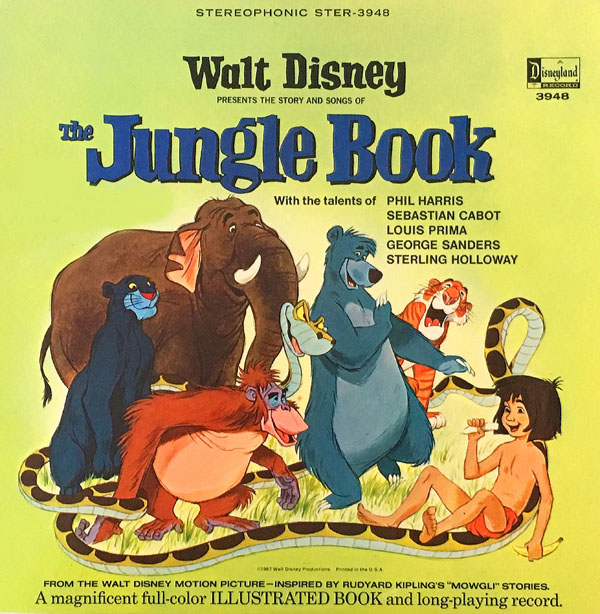
Walt Disney Presents
The Story and Songs of
THE JUNGLE BOOK
Disneyland Records Storyteller Series STER-3948 (Stereo) ST-3948 (Mono) (12” 33 1/3 RPM with Book)
Released in August, 1967. Executive Producer/Script Adaptation: Jimmy Johnson. Producer: Camarata. Musical Score: George Bruns. Orchestrations: Walter Sheets. Editor: Larry Blakely. Engineer: Bruce Botnick. Edited and Mastered at Sunset Sound Recorders, Hollywood. Running Time: 49 minutes.
Voices: Dal McKennon (Bagheera/Narrator); Phil Harris (Baloo); Sebastian Cabot (Bagheera/Soundtrack); Louis Prima (King Louie); George Sanders (Shere Khan); Sterling Holloway (Kaa); Bruce Reitherman (Mowgli); Verna Felton (Mrs. Hathi); J. Pat O’Malley (Colonel Hathi, Buzzy Vulture); Clint Howard (Young Hathi); Chad Stuart (Vulture), Lord Tim Hudson (Vulture); Digby Wolfe (Vulture); Darleen Carr (Girl); Leo DeLyon (Flunkey Monkey); Bill Lee (Shere Khan/Singing Voice); Hal Smith (Elephant, Monkey); Ralph Wright (Elephant); Bill Skiles (Monkey); Pete Henderson (Monkey).
Songs: “Trust in Me,” Colonel Hathi’s March,” “I Wan’na Be Like You,” “That’s What Friends Are For,” “My Own Home,” by Richard M. Sherman, Robert B. Sherman; “The Bare Necessities” by Terry Gilkyson.
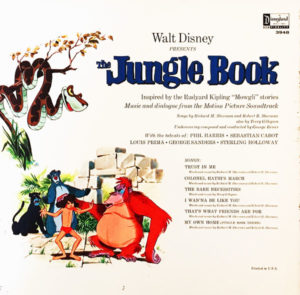 “The Storyteller record album of The Jungle Book accomplished what few children’s records have,” wrote Disneyland Records president Jimmy Johnson in his 1975 autobiography, Inside the Whimsy Works: My 37 Years with Walt Disney Productions. “It was awarded a Gold Record by the Record Industry Association of America. The criterion, established by the RIAA to secure the award, is to sell one million dollars’ worth of records at one-third of the retail price. The retail price of The Jungle Book Storyteller was $3.98, so the figure for the gold was $1.33. Most pop records retail for five or six dollars. If it’s six, the figure for the gold is two dollars, so it is obvious that a pop record is going to pile up the one million dollars a great deal faster than the children’s album selling for less. Nonetheless, The Jungle Book made it.”
“The Storyteller record album of The Jungle Book accomplished what few children’s records have,” wrote Disneyland Records president Jimmy Johnson in his 1975 autobiography, Inside the Whimsy Works: My 37 Years with Walt Disney Productions. “It was awarded a Gold Record by the Record Industry Association of America. The criterion, established by the RIAA to secure the award, is to sell one million dollars’ worth of records at one-third of the retail price. The retail price of The Jungle Book Storyteller was $3.98, so the figure for the gold was $1.33. Most pop records retail for five or six dollars. If it’s six, the figure for the gold is two dollars, so it is obvious that a pop record is going to pile up the one million dollars a great deal faster than the children’s album selling for less. Nonetheless, The Jungle Book made it.”
Even in the case of Buena Vista’s “original cast sound track” album of Mary Poppins, which we celebrated here, it sold for a higher retail price than The Jungle Book Storyteller album, so it had a faster track to a gold record as well.
Another thing to keep in mind is that The Jungle Book album was released amid increased competition, when the kid-friendly Monkees were selling millions of records, “bubblegum pop” was on the rise, and The Beatles were still going strong with a Saturday morning cartoon show that taught tots the words to their songs, including increasingly sophisticated ones like “Eleanor Rigby” and “Strawberry Fields.”
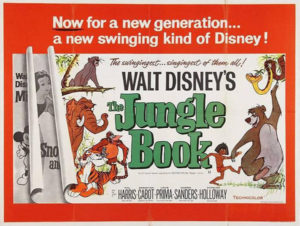 There are a number of reasons why The Jungle Book Storyteller album works so well. It began with Walt Disney’s instinct to turn Kipling’s adventure into a comedic romp, eschewing a darker storyline by Bill Peet and an entire score except for “The Bare Necessities” by Terry Gilkyson. Audiences, particularly those facing an increasing darker and uncertain world in the late ‘60s, responded positively to his decision. Director Wolfgang Reitherman’s successive formula of strong character set pieces against a basic story line was at its highest point since 101 Dalmatians, a recipe that was repeated but never equaled.
There are a number of reasons why The Jungle Book Storyteller album works so well. It began with Walt Disney’s instinct to turn Kipling’s adventure into a comedic romp, eschewing a darker storyline by Bill Peet and an entire score except for “The Bare Necessities” by Terry Gilkyson. Audiences, particularly those facing an increasing darker and uncertain world in the late ‘60s, responded positively to his decision. Director Wolfgang Reitherman’s successive formula of strong character set pieces against a basic story line was at its highest point since 101 Dalmatians, a recipe that was repeated but never equaled.
As a work of pure audio, this album is a masterpiece because each performer is a virtuoso of vocal strength and subtle nuance. The dialogue sections are a delight for repeat playing, even for those who haven’t seen the film. Once Phil Harris, for instance, was allowed to make Baloo into a variation of his radio and TV persona, he and the animators crafted a character was established that was so strong that it took Bill Murray to give it a valid redefinition almost half a century later in Jon Favreau’s 2016 film.
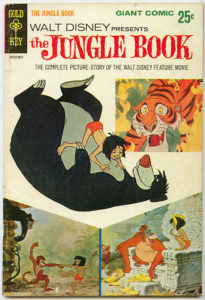 It may come as a surprise that the editor of these segments didn’t see the film before he put the album together either. The final film was not provided to Sunset Sound in order to make Storyteller albums, as the records had to be made in advance. Jimmy Johnson, who by this time was the scriptwriter, may have seen a rough cut, but that may not have been possible (even today, many Disney read-alongs are written with a script in hand long before the film is ready to view).
It may come as a surprise that the editor of these segments didn’t see the film before he put the album together either. The final film was not provided to Sunset Sound in order to make Storyteller albums, as the records had to be made in advance. Jimmy Johnson, who by this time was the scriptwriter, may have seen a rough cut, but that may not have been possible (even today, many Disney read-alongs are written with a script in hand long before the film is ready to view).
Editor Larry Billman explained the process to Tim Hollis and me in Mouse Tracks: The Story of Walt Disney Records: “When we would do a movie soundtrack album, the Disney studio would send the whole movie and the music on quarter-inch stereo tape. My job was to cut it down and assemble a twenty or thirty-minute record from a two-hour movie. I had no script or visual guidelines from the movie. So, with an editing block and a razor blade, I’d soon be up to my knees in edited tape! We would cut a master disc, they’d ship it to the processing plant and make the records.”
Larry may have had Johnson’s adaptation as a guide, if it was available at the time of editing, but it could just as easily have been done in reverse.
Dal McKennon (discussed last week in our Gumby Spin) did an impressive Sebastian Cabot impression—complete with his thoughtful signature “harrumph”—as the narrator, so much so that it is conceivable that many never realized that there are two Bagheeras on the record (though McKennon’s voice is slightly higher). McKennon’s performance was also recorded separately at Sunset Sound, while the dialogue was created at the Disney studio, resulting in a different tonal quality between the narration and the character voices.
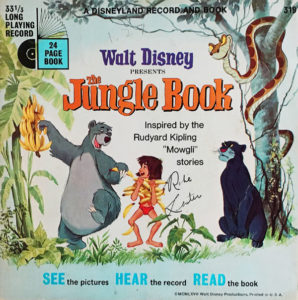 The Jungle Book Storyteller was such a success, it’s a bit of a shame that the Storytellers for the next two animated features released during Johnson’s tenure, The Aristocats and Robin Hood, did not enjoy exactly the same level of adherence to their source material. For whatever reasons—keeping in mind that the Disney Studios were undergoing many changes in the ‘70s—The Aristocats was mostly a studio cast production, wonderful as it was; and Robin Hood was a soundtrack dialogue album but it had none of George Bruns’ background music. We had to wait 44 years for the Legacy Collection CD to get that!
The Jungle Book Storyteller was such a success, it’s a bit of a shame that the Storytellers for the next two animated features released during Johnson’s tenure, The Aristocats and Robin Hood, did not enjoy exactly the same level of adherence to their source material. For whatever reasons—keeping in mind that the Disney Studios were undergoing many changes in the ‘70s—The Aristocats was mostly a studio cast production, wonderful as it was; and Robin Hood was a soundtrack dialogue album but it had none of George Bruns’ background music. We had to wait 44 years for the Legacy Collection CD to get that!
The Jungle Book records included 45 RPM singles of the principal songs, EP’s with four songs, and a 1967 read-along featuring “Disneyland Story Reader” Robie Lester reading the book on side one and two songs on side two. Some early editions of this book and record set erroneously identified “I Wan’na Be Like You” on the label when it was “Trust in Me” on the record. The read-along was revised in 1977 by producer Jymn Magon and writer Les Perkins with a full cast and Sebastian Cabot sound-alike (and occasional Family Affair guest actor) Laurie Main. On both the 1967 and 1977 read-alongs, the studio cast “Jungle VIP” versions of the songs were used, which we explored in this Spin.
“Bare Necessities” Sequences from The Jungle Book Storyteller
Someone recorded this section for you to enjoy.

Walt Disney Presents
The Original Cast Sound Track of
THE JUNGLE BOOK
Buena Vista Records STER-4041 (Stereo) BV-4041 (Mono) (12” 33 1/3 RPM)
Released in December, 1967. Executive Producer: Jimmy Johnson. Producer: Camarata. Musical Score: George Bruns. Orchestrations: Walter Sheets. Editor: Larry Blakely. Engineer: Bruce Botnick. Edited and Mastered at Sunset Sound Recorders, Hollywood. Running Time: 34 minutes.
Voices: Phil Harris (Baloo); Sebastian Cabot (Bagheera/Soundtrack); Louis Prima (King Louie); George Sanders (Shere Khan); Sterling Holloway (Kaa); Bruce Reitherman (Mowgli); Verna Felton (Mrs. Hathi); J. Pat O’Malley (Colonel Hathi, Buzzy Vulture); Clint Howard (Young Hathi); Chad Stuart (Vulture), Lord Tim Hudson (Vulture); Digby Wolfe (Vulture); Darleen Carr (Girl); Leo DeLyon (Flunkey Monkey); Bill Lee (Shere Khan/Singing Voice); Hal Smith (Elephant, Monkey); Ralph Wright (Elephant); Bill Skiles (Monkey); Pete Henderson (Monkey).
Songs: “Trust in Me,” Colonel Hathi’s March,” “I Wan’na Be Like You,” “That’s What Friends Are For,” “My Own Home,” by Richard M. Sherman, Robert B. Sherman; “The Bare Necessities” by Terry Gilkyson.
Instrumental: Main Title.
Dialogue Selections: “Colonel Hathi’s Inspection,” “Colonel Hathi to the Rescue.”
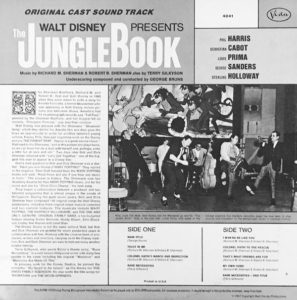 With several exceptions, this is a similar album to the Disneyland Storyteller LP described above without Dal McKennon’s narration. One major difference is that it includes the complete main title music, which fades off on the Storyteller record.
With several exceptions, this is a similar album to the Disneyland Storyteller LP described above without Dal McKennon’s narration. One major difference is that it includes the complete main title music, which fades off on the Storyteller record.
Both of the Colonel Hathi sequences are also included, the first of which, “Inspection” is over one minute longer than on the Storyteller. The end duet with Baloo and Bagheera, edited down on the Storyteller, is also presented on this album at the full length it was heard in the film.
The album was released in this Buena Vista package was to provide a soundtrack album formatted for adult record buyers, using the same “original cast sound track” phrase coined for the Mary Poppins LP. The album cover favors design over large character images and the back cover has a photo of Louis Prima’s band playing at the Disney Studios.
Like Mary Poppins, The Jungle Book offered Buena Vista marketable celebrity talents that appealed to adults who watched TV comedies, variety shows and talk shows and/or saw these performers on stage. The gatefold contains profiles of all the headliners, as well as some of the voices who received less attention, like Chad Stuart of the pop group Chad and Jeremy (they appeared on The Dick Van Dyke Show and Batman) and even Digby Wolfe, an actor and writer for Rowan and Martin’s Laugh-In, which had just premiered on NBC.
What is not widely known about The Jungle Book–and many other Disney film, TV and theme park projects of the ’50s, ‘60s and ‘70s—are details about the direct involvement of Disneyland/Vista Records, Jimmy Johnson and Tutti Camarata in creative input, even those outside of the making of records. It was Johnson who suggested Louis Prima for the role of King Louis.
Johnson recalls: “Phil Harris had just been cast as the voice of Baloo the bear, and I felt that Louis would be a great foil in the part of King Louie. I recommended him to Walt, who was a bit dubious at first.
“Louis really wanted the part. He brought his entire band down to Burbank, at his own expense, to audition for Walt and the animators. They set up on one of the sound stages and went into their regular Vegas act. As part of the act, Louis’ drummer put on a rubber ape mask and drummed away with a whole fistful of sticks, flipping them into the air, catching them, then drumming all over the room on chairs, on the floor, and on other instruments.
“It’s a hilarious bit and it broke up the animators. If you look closely at the monkey sequence in The Jungle Book, you will see one of the apes ‘playing’ bananas like drumsticks. This and some of the other antics of Louis and his crew also found their way into the film.”
Another little-known talent involved in The Jungle Book was Leo DeLyon, best known to cartoon fans as the voice of Brain and Spook on Hanna-Barbera’s prime time animated Top Cat series. He was adept at imitating instruments and creating unusual vocal sounds, and he did so for “I Wan’na Be Like You.” Years later, he did the voice of King Louie for a Disneyland album called Mousercise.
The Buena Vista LP version of The Jungle Book did not enjoy the same wide circulation as the Storyteller and is not as easy to find today. In an interesting twist, after the Buena Vista album was discontinued, the phrase “original cast sound track” was actually added to the later front covers of the Storyteller!
Buena Vista 45 RPM Single Version of “I Wan’na Be Like You”
This is the song minus the dialogue sections as it was released as a single for retail sales and radio play. Note that Buena Vista labels it “original cast sound track,” to differentiate it from the Disneyland singles, which were studio recordings with “The Jungle VIP’s.”


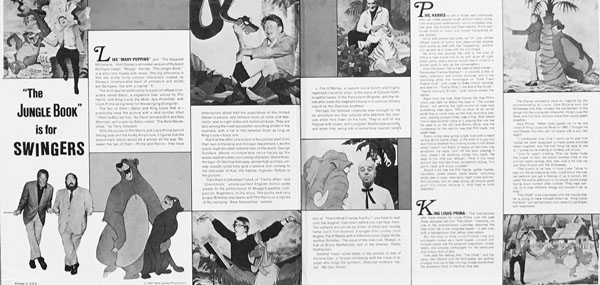
 GREG EHRBAR is a freelance writer/producer for television, advertising, books, theme parks and stage. Greg has worked on content for such studios as Disney, Warner and Universal, with some of Hollywood’s biggest stars. His numerous books include Mouse Tracks: The Story of Walt Disney Records (with Tim Hollis). Visit
GREG EHRBAR is a freelance writer/producer for television, advertising, books, theme parks and stage. Greg has worked on content for such studios as Disney, Warner and Universal, with some of Hollywood’s biggest stars. His numerous books include Mouse Tracks: The Story of Walt Disney Records (with Tim Hollis). Visit 






















































I believe the original DVD release of The Jungle Book has a special feature that shows film footage of Louis Prima & Co doing that bit for the animators.
Funny how you mention the “tonal qualities” of the dialog from Disney soundtracks featured on LPs or CDs – they have such a distinctive sound! I always think of Mr Banks’ dialog from the Mary Poppins soundtrack LP as a perfect example of that (“…sup-uh-kuh- sup-uh-kuh…”)!
Years before Jungle Book, Phil Harris and Louis Prima recorded songs from Fun and Fancy Free which was released on a 78rpm.
“Flunky Monkey” is the greatest acting credit in the history of entertainment.
It’s almost an ice cream flavor, too.
I’m so thrilled that Spin readers enjoy the credit listings as much as I do!
“The Buena Vista LP version of The Jungle Book did not enjoy the same wide circulation as the Storyteller and is not as easy to find today.” The album, interesting enough, was repurposed as a picture disc in 1981 on the Disneyland label proper. In that instance, many of the longer tracks (the two Colonel Hathi scenes and “That’s What Friends Are For”) are edited down to just include the songs.
Hiya all! This film “The Jungle Book ” and its sound track – particularly Bare necessities and I Wan’na Be Like You “King of the Swingers” (is what I have always called it), is the best. Louis Prima has an album called “The Best of Louis Prima” and that album has the best sound recording that I have ever found. Most of them sound like they are recorded in the old way of playing back into a bigger sound horn used in the reverse idea and cutting the groove.
I’ve got to find it on CD because mine is a tape that is and has been played more than any of my wide range of styles, era’s, played loud and clear. I am dancing singing full on, recommend finding it, people who look Louis Prima up and don’t find this LP will miss out on such an excellent-exciting-energetic-ecstatic-enthusiastic-expert-entertainer; enjoy-experiencing-every-evolution-effectively-enhanced-edition! Is that Enough for you?
I’m a musician, Trumpet & Flugelhorn, I’ve got my 1967 Disneyland Walt Disney 7inch 33 1/3 Read Along with Bare Necessities, Wanna be like you, reader Jean Audrey, dark blue made in GB, and by chance 20+ years ago I found just the 7inch 331/3 read along with “strange behaviour ” “col Hathi’s March”& “my own Home “?? reader is Tony Brandon, made in GB but it is 1970? Dark blue, Disneyland label like the original 67 one apart from the writing is a bit smaller and doesn’t have the 2 lines across the middle each side of the hole, before I found you here following the sleave cover (that you don’t seem to have) the few I found with the same label and dark blue didn’t seem to have the same tunes and why did the 1970 record get released? I have never looked into this before and I think you might have an idea of my tendency in unnecessarily over thinking lol, ADHD is supposed to ease off with age, but I’ve always done things backwards, so any information would be great, thanks.